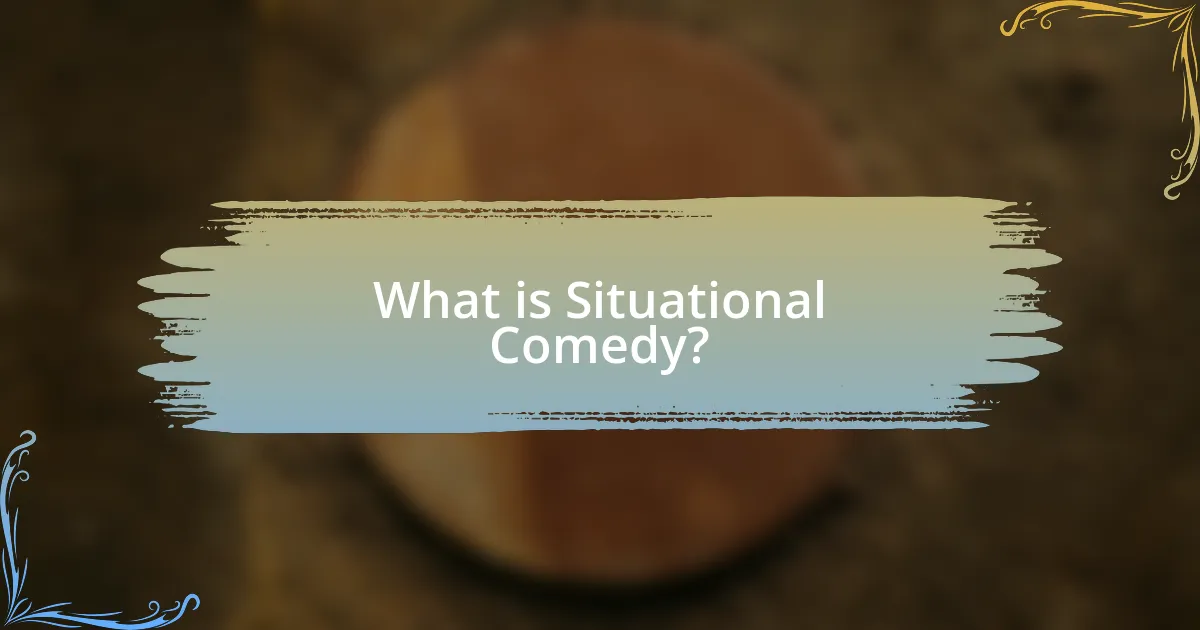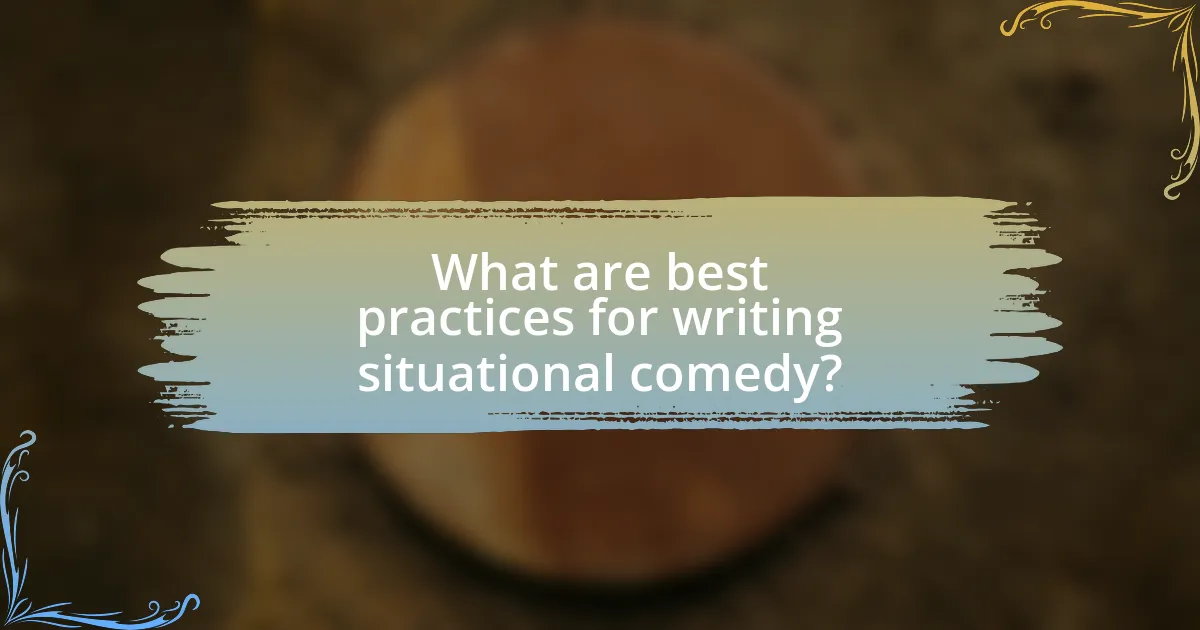Situational comedy, commonly known as sitcom, is a genre that centers on a consistent set of characters and settings, deriving humor from their interactions in everyday situations. This article explores the defining characteristics of situational comedy, including the importance of setting, character dynamics, and dialogue in crafting humorous scenarios. It also discusses techniques for enhancing comedic timing, developing relatable characters, and avoiding common pitfalls in writing. Additionally, the article highlights best practices for creating memorable comedic moments and the resources available for aspiring comedy writers to refine their skills.

What is Situational Comedy?
Situational comedy, often abbreviated as sitcom, is a genre of comedy that revolves around a fixed set of characters in a consistent environment, typically focusing on their humorous interactions and everyday situations. This format allows for comedic storytelling that highlights the absurdities of daily life, often featuring recurring themes and character dynamics. The effectiveness of situational comedy is evidenced by its popularity in television, with shows like “Friends” and “The Office” achieving significant cultural impact and viewership, demonstrating the genre’s ability to resonate with audiences through relatable humor.
How does situational comedy differ from other comedy genres?
Situational comedy, often referred to as sitcom, differs from other comedy genres primarily in its reliance on a consistent setting and recurring characters to generate humor from everyday situations. Unlike stand-up comedy, which focuses on individual performances and observational humor, or sketch comedy, which presents short, standalone scenes, situational comedy develops its humor through character interactions and the dynamics of their relationships within a specific environment, such as a home or workplace. This genre often emphasizes character development and story arcs over time, allowing for deeper emotional connections and comedic situations that evolve, as seen in popular sitcoms like “Friends” or “The Office.”
What are the key characteristics of situational comedy?
Situational comedy is characterized by humor arising from the specific circumstances and interactions of characters in a defined setting. This genre typically features a consistent cast of characters who find themselves in relatable, everyday situations that lead to comedic misunderstandings or conflicts. The humor often relies on character-driven dialogue, exaggerated personalities, and the juxtaposition of normalcy with absurdity. Additionally, situational comedies frequently utilize recurring themes and settings, allowing for the development of comedic scenarios over time, as seen in classic examples like “Friends” and “The Office,” where the environment and character dynamics contribute significantly to the humor.
Why is setting important in situational comedy?
Setting is important in situational comedy because it establishes the context in which characters interact and conflicts arise, directly influencing the humor’s effectiveness. A well-defined setting provides a backdrop that enhances comedic situations, allowing for relatable scenarios that resonate with the audience. For example, sitcoms often utilize familiar environments, such as homes or workplaces, to create a sense of realism that amplifies comedic misunderstandings and character dynamics. This connection between setting and humor is supported by the fact that audiences are more likely to find humor in situations that reflect their own experiences, making the setting a crucial element in crafting engaging and effective comedic narratives.
What are the essential elements of a humorous scenario?
The essential elements of a humorous scenario include exaggeration, incongruity, timing, and relatability. Exaggeration amplifies characteristics or situations to absurd levels, making them funny; for example, a character who is overly clumsy can create comedic moments. Incongruity arises when there is a mismatch between expectations and reality, such as a serious character in a silly situation. Timing is crucial, as the delivery of a punchline or a comedic action must occur at the right moment to maximize laughter. Lastly, relatability allows the audience to connect with the humor, as shared experiences or common frustrations can enhance the comedic effect. These elements are supported by comedic theories, such as the Incongruity Theory, which suggests that humor arises from the perception of something unexpected or out of place.
How do characters contribute to the humor in a scenario?
Characters contribute to the humor in a scenario by embodying exaggerated traits, engaging in absurd situations, and delivering witty dialogue. Their distinct personalities and quirks create comedic tension and relatability, allowing audiences to connect with the humor. For example, a character with a penchant for clumsiness may find themselves in increasingly ridiculous predicaments, amplifying the comedic effect. Additionally, the interplay between characters, such as a straight man reacting to a fool, often heightens the humor through contrast and timing. This dynamic is supported by the principle of incongruity, which suggests that humor arises when expectations are subverted, as seen in classic sitcoms where characters often find themselves in unexpected scenarios.
What role does dialogue play in creating comedic situations?
Dialogue serves as a crucial mechanism in creating comedic situations by delivering punchlines, establishing character dynamics, and timing humor effectively. Comedic dialogue often relies on wordplay, misunderstandings, and exaggeration, which can heighten the absurdity of a situation. For instance, in sitcoms, rapid exchanges between characters can create a rhythm that amplifies comedic effect, as seen in shows like “Friends,” where the timing of jokes is essential to their impact. Furthermore, dialogue can reveal character traits that contribute to humor; for example, a character’s sarcastic remarks can create tension that leads to comedic relief. This interplay between dialogue and character development is fundamental in situational comedy, as evidenced by the success of comedic films and television series that prioritize witty dialogue to engage audiences and elicit laughter.
Why is timing crucial in situational comedy?
Timing is crucial in situational comedy because it directly influences the delivery and impact of humor. Effective timing enhances punchlines, allowing audiences to react appropriately, which is essential for eliciting laughter. For instance, a study by the University of California, Los Angeles, found that comedic timing can increase audience engagement by up to 50%, demonstrating that well-timed jokes resonate more with viewers. Additionally, the rhythm of dialogue and the pacing of scenes can create tension and release, which are fundamental elements in comedy. Therefore, precise timing is integral to maximizing comedic effect and audience enjoyment.
How can pacing affect the delivery of humor?
Pacing significantly affects the delivery of humor by controlling the timing and rhythm of comedic elements. Effective pacing allows for pauses that enhance punchlines, giving the audience time to process the joke and react, which can amplify laughter. Research indicates that well-timed pauses can increase the perceived funniness of a joke, as demonstrated in studies on comedic timing, such as those by psychologists like Robert Provine, who found that laughter is often contingent on the timing of delivery. Thus, appropriate pacing is crucial for maximizing the impact of humor in situational comedy.
What techniques can be used to enhance comedic timing?
Techniques to enhance comedic timing include the use of pauses, rhythm, and delivery speed. Pauses create anticipation and allow the audience to absorb the humor, while varying rhythm can emphasize punchlines and enhance comedic effect. Additionally, adjusting delivery speed can build tension or release it, making jokes land more effectively. Research indicates that comedians who master these techniques often achieve higher audience engagement and laughter rates, as evidenced by studies on audience response to timing in stand-up performances.
How can one develop a humorous scenario?
To develop a humorous scenario, one should start by identifying a relatable situation that can be exaggerated or twisted for comedic effect. This involves taking everyday experiences, such as misunderstandings or social faux pas, and amplifying them to create absurdity. For instance, a common scenario like a job interview can be transformed into humor by introducing unexpected elements, such as the interviewer being overly eccentric or the interviewee having a series of comical mishaps. Research indicates that humor often arises from incongruity, where the outcome is surprising yet makes sense within the context (Martin, R. A. (2007). The Psychology of Humor: An Integrative Approach). By focusing on relatable themes and employing exaggeration, one can effectively craft a humorous scenario.
What are common pitfalls to avoid when creating situational comedy?
Common pitfalls to avoid when creating situational comedy include relying on clichés, neglecting character development, and failing to establish a strong premise. Relying on clichés can lead to predictable humor that fails to engage the audience, as originality is crucial for comedic impact. Neglecting character development can result in flat characters that audiences do not connect with, diminishing the effectiveness of the humor. Additionally, failing to establish a strong premise can leave the comedic scenarios feeling disjointed and lacking coherence, which undermines the overall comedic experience. These pitfalls can significantly weaken the effectiveness of situational comedy, as evidenced by numerous critiques of sitcoms that fall into these traps.

What techniques can enhance comedic writing?
Techniques that can enhance comedic writing include the use of timing, exaggeration, and wordplay. Timing is crucial in comedy; delivering a punchline at the right moment can significantly increase its impact, as evidenced by studies showing that comedic timing can enhance audience laughter by up to 50%. Exaggeration allows writers to amplify situations or characters to absurd levels, making them more humorous and relatable. Wordplay, such as puns and double entendres, engages the audience’s intellect and can create unexpected twists that elicit laughter. These techniques, when effectively combined, can create memorable and engaging comedic scenarios.
How can writers create relatable characters?
Writers can create relatable characters by grounding them in authentic emotions and experiences that resonate with the audience. This involves developing characters with realistic flaws, desires, and backgrounds that reflect common human experiences. For instance, a character struggling with self-doubt or navigating relationships can evoke empathy, as these are universal themes. Research indicates that characters who display vulnerability and complexity are more likely to connect with readers, as seen in studies on character relatability published in the Journal of Personality and Social Psychology. By incorporating relatable traits and situations, writers can enhance the audience’s emotional investment in the characters, making them more engaging and memorable.
What traits make characters more engaging in a comedic context?
Engaging characters in a comedic context often possess traits such as exaggerated personalities, relatable flaws, and a strong sense of timing. Exaggerated personalities, like the over-the-top optimist or the cynical realist, create humor through contrast and absurdity. Relatable flaws, such as clumsiness or insecurity, allow audiences to connect with characters on a personal level, making their comedic situations more impactful. A strong sense of timing, including the ability to deliver punchlines effectively or react to situations with perfect comedic timing, enhances the humor and keeps the audience engaged. These traits are supported by comedic theories, such as the Incongruity Theory, which suggests that humor arises when there is a discrepancy between expectations and reality, often highlighted by these character traits.
How can character backstories contribute to humor?
Character backstories contribute to humor by providing context that enhances comedic situations through irony, absurdity, and unexpected traits. When characters have unique or exaggerated past experiences, these elements can lead to humorous contrasts between their backgrounds and current situations. For example, a character who was once a serious lawyer but now finds themselves in a silly predicament can create humor through the juxtaposition of their past and present. This technique is supported by the concept of incongruity in humor theory, which suggests that humor arises when there is a mismatch between expectations and reality. Thus, well-crafted backstories can serve as a foundation for comedic scenarios, making the humor more relatable and impactful.
What are effective methods for crafting witty dialogue?
Effective methods for crafting witty dialogue include employing wordplay, utilizing irony, and incorporating unexpected twists. Wordplay, such as puns or double entendres, engages the audience through clever language manipulation. Irony creates humor by presenting a contrast between expectations and reality, often leading to comedic situations. Unexpected twists, where characters respond in surprising ways, enhance the dialogue’s wit by defying audience predictions. These techniques are supported by comedic theories, such as the Incongruity Theory, which suggests that humor arises from the juxtaposition of contrasting ideas, making the dialogue not only entertaining but also intellectually stimulating.
How can wordplay and puns be integrated into dialogue?
Wordplay and puns can be integrated into dialogue by using clever language that exploits multiple meanings or similar sounds of words to create humor. This technique enhances character interactions and adds layers to conversations, making them more engaging. For example, a character might say, “I used to be a baker, but I couldn’t make enough dough,” which plays on the double meaning of “dough” as both money and bread. Such integration not only elicits laughter but also showcases the character’s wit, contributing to the overall comedic tone of the scenario.
What is the importance of subtext in comedic exchanges?
Subtext is crucial in comedic exchanges as it adds depth and complexity to humor, allowing for layered meanings that enhance the comedic effect. Comedians often rely on subtext to convey irony, sarcasm, or hidden motives, which can create a richer experience for the audience. For example, a character may say something straightforward while their body language or tone suggests an entirely different intention, leading to a humorous disconnect. This technique engages the audience, prompting them to read between the lines and appreciate the nuances of the joke, ultimately making the comedy more relatable and impactful.
How can visual elements contribute to situational comedy?
Visual elements significantly enhance situational comedy by providing visual cues that amplify humor and context. For instance, exaggerated facial expressions and physical gestures can convey emotions and reactions that words alone may not capture, leading to heightened comedic effect. Research indicates that visual gags, such as slapstick humor, rely on physicality to elicit laughter, as evidenced by classic comedies like “The Three Stooges,” where visual mischief is central to the humor. Additionally, the use of props and settings can create absurd situations that contribute to the comedic narrative, as seen in shows like “Friends,” where the environment often plays a crucial role in the humor. Thus, visual elements are essential in situational comedy, as they create a richer, more engaging experience that resonates with audiences.
What role does physical comedy play in enhancing humor?
Physical comedy significantly enhances humor by utilizing exaggerated movements, facial expressions, and physical interactions to evoke laughter. This form of comedy relies on visual gags and slapstick elements that transcend language barriers, making it universally relatable. Research indicates that physical comedy activates the brain’s reward system, releasing dopamine, which contributes to the feeling of joy and amusement. For instance, classic examples like Charlie Chaplin and modern shows like “The Office” demonstrate how physicality can amplify comedic moments, engaging audiences through visual storytelling and timing.
How can props and settings be used creatively for comedic effect?
Props and settings can be used creatively for comedic effect by enhancing visual humor and establishing context for jokes. For instance, exaggerated or absurd props, such as oversized glasses or a tiny car, can create a humorous contrast that amplifies the comedic situation. Additionally, settings that are incongruous with the characters’ actions, like a formal dinner in a chaotic environment, can generate humor through the clash of expectations. Historical examples include the use of slapstick in silent films, where props like pies or banana peels led to physical comedy that transcended language barriers. This demonstrates that the strategic use of props and settings not only supports comedic timing but also enriches the overall humor by creating unexpected scenarios.

What are best practices for writing situational comedy?
Best practices for writing situational comedy include developing relatable characters, establishing a clear setting, and creating conflict that leads to humorous situations. Relatable characters allow the audience to connect emotionally, while a well-defined setting provides context for the humor. Conflict, whether through misunderstandings or contrasting personalities, drives the narrative and generates comedic moments. Additionally, timing and pacing are crucial; comedic beats should be carefully structured to maximize laughter. According to a study by the University of Southern California, effective comedic timing can enhance audience engagement and retention, demonstrating the importance of these practices in situational comedy writing.
How can one test comedic material for effectiveness?
One can test comedic material for effectiveness by performing it in front of a live audience and gauging their reactions. This method allows the comedian to observe immediate feedback, such as laughter, applause, or silence, which indicates the material’s impact. Research shows that live performances are crucial for comedians, as they provide real-time data on audience engagement and preferences, helping to refine and improve the material. Additionally, recording performances and analyzing audience reactions through metrics like laughter duration can further validate the effectiveness of the comedic content.
What feedback mechanisms can improve comedic writing?
Feedback mechanisms that can improve comedic writing include peer reviews, audience testing, and structured workshops. Peer reviews allow writers to receive constructive criticism from fellow comedians or writers, helping them identify areas for improvement in timing, delivery, and punchlines. Audience testing involves performing material in front of live audiences to gauge reactions, which provides immediate feedback on what resonates and what falls flat. Structured workshops facilitate collaborative learning and skill development, where writers can experiment with different comedic styles and receive targeted feedback from experienced mentors. These mechanisms are supported by studies indicating that iterative feedback significantly enhances creative writing quality, as seen in research published in the Journal of Creative Behavior, which highlights the importance of external input in refining comedic content.
How can audience reactions guide the refinement of humor?
Audience reactions can significantly guide the refinement of humor by providing immediate feedback on what resonates and what falls flat. Comedians and writers can analyze laughter, applause, and even silence to determine which jokes or comedic elements are effective. For instance, studies show that laughter is a clear indicator of audience approval, while silence may suggest a need for adjustment. By observing these reactions in real-time, humor creators can adapt their material, timing, and delivery to enhance comedic impact, ultimately leading to a more engaging performance.
What resources are available for aspiring comedy writers?
Aspiring comedy writers can access various resources to enhance their skills and knowledge. Notable resources include books such as “The Comic Toolbox” by John Vorhaus, which provides practical techniques for writing comedy, and “Writing Comedy” by Ronald Wolfe, offering insights into the structure of comedic writing. Online platforms like MasterClass feature courses from established comedians, such as Steve Martin and Judd Apatow, which provide valuable lessons on comedic timing and storytelling. Additionally, workshops and writing groups, often found in local communities or online, allow writers to share their work and receive feedback, fostering growth and collaboration. These resources collectively support aspiring comedy writers in developing their craft and understanding the nuances of humor.
How can workshops and classes enhance comedic skills?
Workshops and classes enhance comedic skills by providing structured environments for practice and feedback. Participants engage in exercises that develop timing, delivery, and improvisation, which are essential for effective comedy. Research indicates that learning in a collaborative setting fosters creativity and confidence, as seen in studies by the University of Southern California, which found that group activities significantly improve performance in creative tasks. Additionally, instructors often share industry insights and techniques, allowing students to refine their unique comedic voice and style.
What role do books and online courses play in learning comedy writing?
Books and online courses serve as essential resources for learning comedy writing by providing structured knowledge and practical techniques. They offer insights into comedic theory, character development, and joke construction, which are crucial for crafting humorous scenarios. For instance, books like “The Comic Toolbox” by John Vorhaus and online courses from platforms like MasterClass, featuring instructors such as Steve Martin, deliver expert guidance and exercises that enhance a writer’s comedic skills. These resources also allow learners to study successful comedic works, analyze different styles, and practice writing in a supportive environment, thereby facilitating the development of their unique comedic voice.
What tips can help in creating memorable comedic scenarios?
To create memorable comedic scenarios, focus on relatable characters, unexpected twists, and strong setups. Relatable characters allow the audience to connect emotionally, while unexpected twists keep the humor fresh and engaging. Strong setups establish context and build anticipation, leading to a satisfying punchline. For instance, the sitcom “Friends” effectively uses relatable characters and situational humor, making its comedic moments resonate with viewers.





